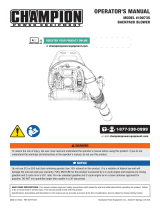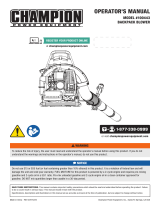
6
200947 - WALK BEHIND BLOWER
IMPORTANT SAFETY INSTRUCTIONS
WARNING
Rapid retraction of the starter cord will pull hand and arm
towards the engine faster than you can let go. Unintentional
startup can result in entanglement, traumatic amputation or
laceration. Broken bones, fractures, bruises or sprains could
result.
When starting engine, pull the starter cord slowly until
resistance is felt and then pull rapidly to avoid kickback.
CAUTION
Prolonged exposure to vibrations, also known as vibration
white finger, through use of gasoline-powered equipment,
such as this blower, could cause blood vessel or nerve damage
in fingers, hands, and joints. If symptoms occur such as
numbness, or loss of feeling in the fingers, hands, or joints,
discontinue the use of this blower and seek medical attention.
Fuel Safety
DANGER
GASOLINE AND GASOLINE VAPORS ARE HIGHLY
FLAMMABLE AND EXPLOSIVE.
Fire or explosion can cause severe burns or death.
Gasoline and gasoline vapors:
– Gasoline is highly flammable and explosive.
– Gasoline can cause a fire or explosion if ignited.
– Gasoline is a liquid fuel but its vapors can ignite.
– Gasoline is a skin irritant and needs to be cleaned up
immediately if spilled on skin or clothes.
– Gasoline has a distinctive odor, this will help detect potential
leaks quickly.
– In any petroleum gas fire, flames should not be extinguished
unless by doing so the fuel supply valve can be turned OFF.
This is because if a fire is extinguished and a supply of fuel is
not turned OFF, then an explosion hazard could be created.
– Gasoline expands or contracts with ambient temperatures.
Never fill the gasoline tank to full capacity, as gasoline needs
room to expand if temperatures rise.
When adding or removing gasoline:
– DO NOT light or smoke cigarettes.
– Always turn the blower off and let cool for minimum of two
minutes before removing the gasoline cap. Afterwards, loosen
gasoline cap to relieve pressure from the gasoline tank.
– Only fill or drain gasoline outdoors in a well-ventilated area.
– DO NOT pump gasoline directly into the blower at the gas
station. Always use an approved fuel container to transfer the
fuel to the gasoline tank.
– DO NOT overfill the gasoline tank.
– Always keep gasoline away from sparks, open flames, pilot
lights, heat and other sources of ignition.
– Mix and store fuel in a container approved for gasoline.
When starting the blower:
– DO NOT attempt to start a damaged engine.
– Always make certain that the gasoline cap, air filter, spark
plug, fuel lines and exhaust system are properly secured,
connected and in place.
– Always allow spilled gasoline to evaporate fully before
attempting to start the engine.
– Make certain that the blower is resting firmly on level ground.
When operating the blower:
– DO NOT move or tip the blower during operation.
– DO NOT tip the blower or allow fuel or oil to spill.
When storing the blower:
– Store away from sparks, open flames, pilot lights, heat and
other sources of ignition.
– Do not store the blower or gasoline near furnaces, water
heaters, or any other appliances that produce heat or have
automatic ignitions.
WARNING
NEVER use a gasoline container, gasoline tank, or any other
fuel item that is broken, cut, torn or damaged.






























